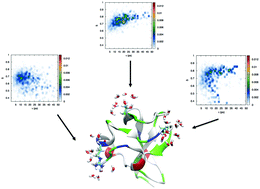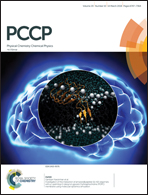Water structure and dynamics in the hydration layer of a type III anti-freeze protein†
Abstract
We report on a molecular dynamics study on the relation between the structure and the orientational (and hydrogen bond) dynamics of hydration water around the ocean pout AFP III anti-freeze protein. We find evidence for an increasing tetrahedral structure from the area opposite to the ice binding site (IBS) towards the protein IBS, with the strongest signal of tetrahedral structure around the THR-18 residue of the IBS. The tetrahedral structural parameter mostly positively correlates with increased reorientation decay times. Interestingly, for several key (polar) residues that are not part of the IBS but are in its vicinity, we observe a decrease of the reorientation time with increasing tetrahedral structure. A similar anti-correlation is observed for the hydrogen-bonded water molecules. These effects are enhanced at a lower temperature. We interpret these results in terms of the structure-making and structure-breaking residues. Moreover, we investigate the tetrahedral structure and dynamics of waters at a partially dehydrated IBS, and for the protein adsorbed at the air–water interface. We find that the mutation changes the preferred protein orientation upon adsorption at an air–water interface. These results are in agreement with the water–air Vibration Sum Frequency Generation spectroscopic experiments showing a strongly reduced tetrahedral signal upon mutation at the IBS.



 Please wait while we load your content...
Please wait while we load your content...